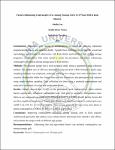Factors Influencing Contraceptive Use Among Teenage Girls 13-19 Years Old in Kole District.
Abstract
Introduction: Adolescent girls’ access to contraceptives is crucial for reducing unplanned pregnancies, abortions, and maternal deaths. Uganda faces challenges in meeting the sexual and reproductive health needs of adolescents, with Kole district particularly at risk of high teenage pregnancy complications. This study aimed to assess the prevalence and factors influencing contraceptive utilization among teenage girls in Kole district.
Methods: The research design was a cross-sectional study, using a quantitative data collection method. The sample size of 289 was determined using the Kish (1965) formula. A multi-stage sampling technique was employed, randomly selecting two villages from each of the three sub-counties. Households within the villages were the unit of analysis, and participants was selected using simple random sampling. Data collection was done using a pretested questionnaire and analysed at univariate, bivariate and multivariate levels.
Results: Results showed that 54.45% of the participants used contraceptives. Socio-cultural factors significantly influenced contraceptive use, with girls in supportive communities more likely to use contraceptives (AOR=0.28, 95% CI: 0.11-0.73, p=0.009). Health facility factors did not show significant associations. Fear of side effects was a significant barrier to contraceptive use (AOR=3.52, 95% CI: 1.51-8.19, p=0.004). Older teenage girls (17-19 years) were more likely to utilize contraceptives (AOR=5.49, 95% CI: 2.48-12.2, p<0.001).
Conclusions: Improving contraceptive utilization among teenage girls in Kole requires multifaceted approaches that address socio-cultural factors that dispel fears related to side effects, and consider the unique needs of different age groups
Recommendations: Addressing fear and age-related factors can promote contraceptive use among teenage girls.
Keywords: Factors, Contraceptive use, Teenage girls.

